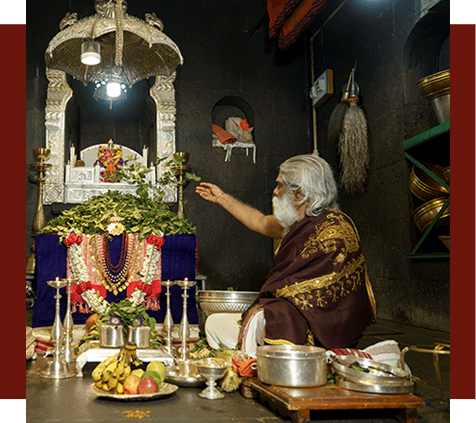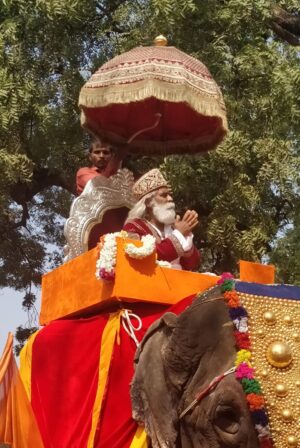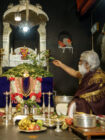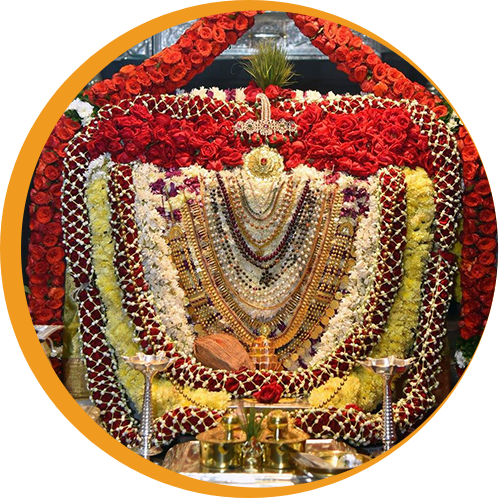
Parampara
Parampara
Shri Martand Manik Prabhu Maharaj



Shri Martand Manik Prabhu Maharaj (1861-1936) was born on 28th December 1861 as the younger son of Shri Tatya Saheb Maharaj Shri Prabhu’s younger brother. He imbibed in him the best of his immediate predecessors, i.e. Shri Manohar Manik Prabhu Maharaj, his elder brother and Shri Prabhu his uncle, in terms of spiritual sadhana, an in-depth understanding of the purpose and mission of Shri Prabhu’s work, an unparalleled command over the Shastras and an incomparable ability to effectively convey to the masses the essence of Shri Prabhu’s message by way of his masterly poetic compositions and writings elucidating the principles of Advaita Siddhant which form the basis of Shri Prabhu’s teachings.
It can be very rightly said that each of the successors of Shri Prabhu was possessed of the Shakti or the Divine Energy, to further enhance the glory of the Sampradaya as its torchbearer. Shri Manohar Manik Prabhu had little time, only twelve years, to consolidate and make the pedestal strong and lasting. Shri Khanderao, who took the name of Shri Martand Manik Prabhu on ascending the Gadi, had fifty-eight years. The Divine Will has its scheme according to which it operates Neither the Lord nor his Cosmic Laws. Spiritual initiation is not like conventional initiation. What is needed to be considered is spiritual time.
Shri Martand Manik Prabhu was more practical and was an activist in spiritual matters. He took it upon himself to explain the basic tenets of Dharma, the Perennial Principles. He mastered philosophy because that was the science of life. Adhyatma Vidya is not only the manifestation but is the Lord himself. Consequently, in his book Dnyan Martand which was his Magnum Opus, even while explaining the Sakalamata Sampradaya, he gave vocal expression to his universal vision. His exposition was easy to understand and could be assimilated even by a layperson. Anyone who makes a Sankalpa (resolve) comes one step nearer to the essence of God has this sourcebook at hand.
Learned thinkers spoke about the lucidity of his expositions. The Pundits of Varanasi called him Abhinava Shankaracharya. He was a tireless writer in Marathi, Hindi, and Kannada. His abhangas are full of philosophical truths. His other books, Guru Sampradaya, Mahamauna Shataka, and Manik Nirvikalpabodha have proved immensely beneficial for the followers of the Sampradaya in understanding its true values. For one who has gone through the lives of the persons who have ascended the Gadi, one thing becomes clear. There is a definite scheme for the exposition of Truth according to the time and the need of the people. While Shri Manik Prabhu Maharaj sourced the Primal Energy, Shri Manohar Manik Prabhu gave it the mystical foundation by laying down the rites and the rituals, stotras, and shlokas of worship and adoration. Then came the time of Shri Martand Manik Prabhu to explain the philosophy behind the Sampradaya, the meaning and the intent behind the Energy which is being handed over from one generation to the other.
Shri Martand Manik Prabhu was not merely a philosopher but also a practitioner. A Sadhaka as well as an Anubhavi. It is one thing to know Truth intellectually and quite different a thing to feel and experience it. This is possible only for those who are seeped in austerities. He had mastered Mantra Shastra and had exceptional Yogic powers. In spite of all these attainments he was like a child and his heart melted for the devotees. His stern exterior belied his immense love and compassion. He was, indeed, a rare combination of Jnana, Bhakti and Vairagya.
He was not content to sit in the ivory tower and contemplate on the Eternal Brahman. He was as much concerned with the life of the common people and the travails through which they were passing. He travelled throughout the length and breadth of the country to propagate the Shri Manik Prabhu Sampradaya, which alone would lift the people from the misery of Samsara. People were awestruck by his imposing personality and words of wisdom.
When it was found that devotees of the Sampradaya had spread throughout India, he decided to publish a magazine to disseminate the message of the Sampradaya. He named the monthly magazine Sakalamatacharya Shri Manik Prabhu and the first issue was released on Datta Jayanti in December 1921. The main objective of the magazine, which was penned by Shreeji himself, was to put concisely the entire philosophy of the Sampradaya. He wrote:
Our purpose is to exchange thoughts with our readers. There should not be any enmity amongst any persons. Spreading love and compassion all around to remove the misery, is our purpose. This is the cardinal teaching of Shri Prabhu. This message should be spread around the world. This is our objective. We may reiterate that the foundation, on which this Sampradaya is based, is LOVE. There exists pure LOVE and nothing else, therefore, no scope for any enmity. Just as the bees select honey irrespective of the type of the flowers, our Sampradaya believes in collecting all the essentials from all religions, creeds, and beliefs and offering them in the collected form at the feet of Shri Prabhu.
Shri Prabhu Sampradaya does not depend on following one or the other path. It depends exclusively on the reflection and meditation of Jnana. Each one should try to acquire Jnana, following the path laid down by his own caste and creed. This is the principle adopted by Sampradaya.
Vedanta Dharma is capable of becoming the sole representative of all the religions of the world. All the existing religions of the world can have access to our Dharma. Moses of Israel, Jesus of the Christians, Paigambar of the Muslims are the same as Shri Prabhu; of the Jains, of the Buddhists or of the Zoroastrians, the Supreme God is the same as ours.
Even as the Sun illumines the whole world, so does Brahman. (One who realizes this) the immanence in all creatures is said to be liberated while alive. All that forms the quintessence of the final teaching of Veda, of Wisdom and of special scriptures is this — I am Self, formless and of all-pervading nature.
Shri Martand Manik Prabhu was the perfect embodiment of the Samanvaya – equipoise. His entire life bears testimony to this fact. His temporal life and the problems which it brought for him, did not disturb his inner composure or peace. He was a perfect Jnani, a Stithaprajna and Gunateeta. As mentioned in the Gita (II.56) He whose mind is untroubled in the midst of sorrows and is free from eager desires amidst pleasures, he, from whom passion, fear and anger have passed away, he is called a sage of settled intelligence (Stithaprajna).
His Magnum Opus Dnyan Martand is a Vedantic Treatise that explains all the fundamental principles which the Sampradaya stands for and for which it came to be established. While it is true that all the Bhajans contain the essence of the teachings of all those who have graced the Gadi, it is never the less necessary that this book should be read as one of the fundamental expositions of the Sampradaya by one who desires to know what the Sampradaya really stands for and how vast was the vision of Shri Manik Prabhu and how deep was the insight of Shri Martand Manik Prabhu. Vedas and Vedanta are the onetime experiences of the Seers who experienced the Supreme Reality. Unless a glimpse of such an experience is realized by us even to an infinitely small extent, life would not be worth living.
Shri Martand Manik Prabhu had an infinite capacity to devote his entire life to the Sampradaya. He took as much interest in the temporal matters of Maniknagar as he did in rejuvenating the spiritual aspirations of the devotees of the Sampradaya. His personality was such that neither people nor wealth was lacking wherever he went. All the wealth received was spent to improve the facilities for the devotees at Maniknagar. During his time he extended Shri Manik Prabhu Maharaj’s Samadhi Mandir and constructed Devi Venkamma’s Temple, Bhandarkhana, Naubatkhana and many other grand buildings in Maniknagar.
Shreeji was himself an accomplished player of Pakhawaj, a percussion instrument. He also was a great patron of Indian classical music. Great maestros such as Pandit Vishnu Digambar Paluskar, Ustad Abdul Kareem Khan Saheb, Ustad Rahmat Khan Saheb, and Pandit Bhaskar Buva Bakhle all performed before him and were honoured by him. Upcoming musicians used to throng to him for his encouragement and blessings. He had started writing a book in Marathi explaining the utility of music in achieving spiritual perfection. He had named the book Gaana Martand and had even prepared several notes to be incorporated in it. Unfortunately, he could not complete the book, which, if completed would have served the purpose of a textbook for the students of Naad Upasana.
The Royal family of the Nizam of Hyderabad had links with Shri Manik Prabhu Samsthan since the time of Shri Manik Prabhu himself. These links were further strengthened during the tenure of Shri Martand Manik Prabhu as the Peethadhipati of the Samsthan. The VII Nizam of Hyderabad, His Exalted Highness Meer Osman Ali Khan Bahadur specially invited Shreeji to Hyderabad and sought his blessings. The then Prime Minister of Hyderabad, Sir Kishan Prashad Bahadur, an acknowledged poet, composed several Urdu couplets describing the greatness of Shreeji.
The Sajjada Nashin (chief priest) of the holy mausoleum at Gulbarga was so impressed with Shreeji’s belief in the oneness of God and his extraordinary command over the teachings of the Koran, that he presented a letter of authority and distinction to Shreeji bestowing upon him the Khilafat (honour and authority) of the exalted Kadaria Order. The Sajjada Nashin in his letter said Truly speaking Martand Manik Prabhu is not a mere follower of Manik Prabhu in piety, Fakeeri and saintliness but has made further progress and has become possessed of all praiseworthy qualities. Finding him perfect in austerity and his belief in the oneness of God, I under the orders of my spiritual guide, am glad and ready to confer upon him the Khilafat of His Holiness Syed Mohammed Mohammed-Al-Hussaini Gesu Daraz Bande Nawaz.
By 1935, Shreeji had travelled extensively for the purpose of the Samsthan. He established many branches of the Samsthan in places like Bombay, Madras, Hyderabad, Pune, Sholapur, and Raichur. This effort had an effect on his health. Age was catching up with him fast and the body was losing its capacity to work through the spirit was willing. He bore illness with stoic indifference.
The illness continued unabated. The thought of a successor to the Gadi was always there in his mind. Shreeji’s long reign had made people immune to the thought that his mortal frame would one day not be with them. In the Darbar during Datta Jayanti in 1935, he made a reference to his ill health and made a remarkable statement, of which few could understand the significance at that time. He said, Tell me with your faith in Shri Prabhu, whether I could die? I am Eternal. Who can perform the Prabhu-Seva except me? When there are so many devotees around me, why should I worry about a successor?
Shri Martand Manik Prabhu had two sons and one daughter. However as willed by the Lord, both the sons left their mortal coils during his lifetime. Anyone else would have despaired, but Shreeji saw the Divine Will in these events.
When Shri Martand Manik Prabhu was busy with his spiritual activities, the administrative matters of the Samsthan were handled by his sister’s son Shri Shankarrao Dikshit. Shreeji had paternal love for this boy. He had great faith in him and all the affairs of the Samsthan were left to his supervision whenever Shreeji would be on tour. He had not only shown excellent administrative ability but also a spiritual bent in attending to the minutest details of the rites and rituals to be conducted at Maniknagar day in and day out. Shri Martand Manik Prabhu had not to search far for his successor.
As the days passed Shreeji found it difficult to perform even the daily rituals and sometimes he had no strength even to change his side in sleep. He gave up taking food and seemed to be lapsing in the realm of the Subtle Silence. There is a belief that the great Yogis when the time comes to shed their bodies, enter the Blissful state, stage by stage withdrawing themselves sheath by a sheath. This is known as withdrawing into one’s Sukshma Sharira from the Gross one. They withdraw step by step and leave the mortal body as the snake sheds its skin. Finally, the day arrived, Thursday, 12th March 1936, when he left his ailing body and entered the Eternal Space, which was essentially his essence
Shri Martand Manik Prabhu Maharaj
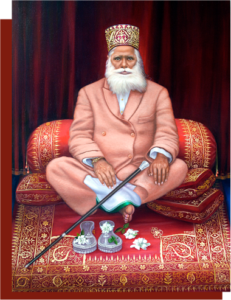
Shri Martand Manik Prabhu Maharaj (1861-1936) was born on 28th December 1861 as the younger son of Shri Tatya Saheb Maharaj Shri Prabhu’s younger brother. He imbibed in him the best of his immediate predecessors, i.e. Shri Manohar Manik Prabhu Maharaj, his elder brother and Shri Prabhu his uncle, in terms of spiritual sadhana, an in-depth understanding of the purpose and mission of Shri Prabhu’s work, an unparalleled command over the Shastras and an incomparable ability to effectively convey to the masses the essence of Shri Prabhu’s message by way of his masterly poetic compositions and writings elucidating the principles of Advaita Siddhant which form the basis of Shri Prabhu’s teachings.
It can be very rightly said that each of the successors of Shri Prabhu was possessed of the Shakti or the Divine Energy, to further enhance the glory of the Sampradaya as its torchbearer. Shri Manohar Manik Prabhu had little time, only twelve years, to consolidate and make the pedestal strong and lasting. Shri Khanderao, who took the name of Shri Martand Manik Prabhu on ascending the Gadi, had fifty-eight years. The Divine Will has its scheme according to which it operates Neither the Lord nor his Cosmic Laws.
Spiritual initiation is not like conventional initiation. What is needed to be considered is spiritual time.
Shri Martand Manik Prabhu was more practical and was an activist in spiritual matters. He took it upon himself to explain the basic tenets of Dharma, the Perennial Principles. He mastered philosophy because that was the science of life. Adhyatma Vidya is not only the manifestation but is the Lord himself. Consequently, in his book Dnyan Martand which was his Magnum Opus, even while explaining the Sakalamata Sampradaya, he gave vocal expression to his universal vision. His exposition was easy to understand and could be assimilated even by a layperson. Anyone who makes a Sankalpa (resolve) comes one step nearer to the essence of God has this sourcebook at hand.
Learned thinkers spoke about the lucidity of his expositions. The Pundits of Varanasi called him Abhinava Shankaracharya. He was a tireless writer in Marathi, Hindi, and Kannada. His abhangas are full of philosophical truths. His other books, Guru Sampradaya, Mahamauna Shataka, and Manik Nirvikalpabodha have proved immensely beneficial for the followers of the Sampradaya in understanding its true values. For one who has gone through the lives of the persons who have ascended the Gadi, one thing becomes clear. There is a definite scheme for the exposition of Truth according to the time and the need of the people. While Shri Manik Prabhu Maharaj sourced the Primal Energy, Shri Manohar Manik Prabhu gave it the mystical foundation by laying down the rites and the rituals, stotras, and shlokas of worship and adoration. Then came the time of Shri Martand Manik Prabhu to explain the philosophy behind the Sampradaya, the meaning and the intent behind the Energy which is being handed over from one generation to the other.
Shri Martand Manik Prabhu was not merely a philosopher but also a practitioner. A Sadhaka as well as an Anubhavi. It is one thing to know Truth intellectually and quite different a thing to feel and experience it. This is possible only for those who are seeped in austerities. He had mastered Mantra Shastra and had exceptional Yogic powers. In spite of all these attainments he was like a child and his heart melted for the devotees. His stern exterior belied his immense love and compassion. He was, indeed, a rare combination of Jnana, Bhakti and Vairagya.
He was not content to sit in the ivory tower and contemplate on the Eternal Brahman. He was as much concerned with the life of the common people and the travails through which they were passing. He travelled throughout the length and breadth of the country to propagate the Shri Manik Prabhu Sampradaya, which alone would lift the people from the misery of Samsara. People were awestruck by his imposing personality and words of wisdom.
When it was found that devotees of the Sampradaya had spread throughout India, he decided to publish a magazine to disseminate the message of the Sampradaya. He named the monthly magazine Sakalamatacharya Shri Manik Prabhu and the first issue was released on Datta Jayanti in December 1921. The main objective of the magazine, which was penned by Shreeji himself, was to put concisely the entire philosophy of the Sampradaya. He wrote:
Our purpose is to exchange thoughts with our readers. There should not be any enmity amongst any persons. Spreading love and compassion all around to remove the misery, is our purpose. This is the cardinal teaching of Shri Prabhu. This message should be spread around the world. This is our objective. We may reiterate that the foundation, on which this Sampradaya is based, is LOVE. There exists pure LOVE and nothing else, therefore, no scope for any enmity. Just as the bees select honey irrespective of the type of the flowers, our Sampradaya believes in collecting all the essentials from all religions, creeds, and beliefs and offering them in the collected form at the feet of Shri Prabhu.
Shri Prabhu Sampradaya does not depend on following one or the other path. It depends exclusively on the reflection and meditation of Jnana. Each one should try to acquire Jnana, following the path laid down by his own caste and creed. This is the principle adopted by Sampradaya.
Vedanta Dharma is capable of becoming the sole representative of all the religions of the world. All the existing religions of the world can have access to our Dharma. Moses of Israel, Jesus of the Christians, Paigambar of the Muslims are the same as Shri Prabhu; of the Jains, of the Buddhists or of the Zoroastrians, the Supreme God is the same as ours.
Even as the Sun illumines the whole world, so does Brahman. (One who realizes this) the immanence in all creatures is said to be liberated while alive. All that forms the quintessence of the final teaching of Veda, of Wisdom and of special scriptures is this — I am Self, formless and of all-pervading nature.
Shri Martand Manik Prabhu was the perfect embodiment of the Samanvaya – equipoise. His entire life bears testimony to this fact. His temporal life and the problems which it brought for him, did not disturb his inner composure or peace. He was a perfect Jnani, a Stithaprajna and Gunateeta. As mentioned in the Gita (II.56) He whose mind is untroubled in the midst of sorrows and is free from eager desires amidst pleasures, he, from whom passion, fear and anger have passed away, he is called a sage of settled intelligence (Stithaprajna).
His Magnum Opus Dnyan Martand is a Vedantic Treatise that explains all the fundamental principles which the Sampradaya stands for and for which it came to be established. While it is true that all the Bhajans contain the essence of the teachings of all those who have graced the Gadi, it is never the less necessary that this book should be read as one of the fundamental expositions of the Sampradaya by one who desires to know what the Sampradaya really stands for and how vast was the vision of Shri Manik Prabhu and how deep was the insight of Shri Martand Manik Prabhu. Vedas and Vedanta are the onetime experiences of the Seers who experienced the Supreme Reality. Unless a glimpse of such an experience is realized by us even to an infinitely small extent, life would not be worth living.
Shri Martand Manik Prabhu had an infinite capacity to devote his entire life to the Sampradaya. He took as much interest in the temporal matters of Maniknagar as he did in rejuvenating the spiritual aspirations of the devotees of the Sampradaya. His personality was such that neither people nor wealth was lacking wherever he went. All the wealth received was spent to improve the facilities for the devotees at Maniknagar. During his time he extended Shri Manik Prabhu Maharaj’s Samadhi Mandir and constructed Devi Venkamma’s Temple, Bhandarkhana, Naubatkhana and many other grand buildings in Maniknagar.
Shreeji was himself an accomplished player of Pakhawaj, a percussion instrument. He also was a great patron of Indian classical music. Great maestros such as Pandit Vishnu Digambar Paluskar, Ustad Abdul Kareem Khan Saheb, Ustad Rahmat Khan Saheb, and Pandit Bhaskar Buva Bakhle all performed before him and were honoured by him. Upcoming musicians used to throng to him for his encouragement and blessings. He had started writing a book in Marathi explaining the utility of music in achieving spiritual perfection. He had named the book Gaana Martand and had even prepared several notes to be incorporated in it. Unfortunately, he could not complete the book, which, if completed would have served the purpose of a textbook for the students of Naad Upasana.
The Royal family of the Nizam of Hyderabad had links with Shri Manik Prabhu Samsthan since the time of Shri Manik Prabhu himself. These links were further strengthened during the tenure of Shri Martand Manik Prabhu as the Peethadhipati of the Samsthan. The VII Nizam of Hyderabad, His Exalted Highness Meer Osman Ali Khan Bahadur specially invited Shreeji to Hyderabad and sought his blessings. The then Prime Minister of Hyderabad, Sir Kishan Prashad Bahadur, an acknowledged poet, composed several Urdu couplets describing the greatness of Shreeji.
The Sajjada Nashin (chief priest) of the holy mausoleum at Gulbarga was so impressed with Shreeji’s belief in the oneness of God and his extraordinary command over the teachings of the Koran, that he presented a letter of authority and distinction to Shreeji bestowing upon him the Khilafat (honour and authority) of the exalted Kadaria Order. The Sajjada Nashin in his letter said Truly speaking Martand Manik Prabhu is not a mere follower of Manik Prabhu in piety, Fakeeri and saintliness but has made further progress and has become possessed of all praiseworthy qualities. Finding him perfect in austerity and his belief in the oneness of God, I under the orders of my spiritual guide, am glad and ready to confer upon him the Khilafat of His Holiness Syed Mohammed Mohammed-Al-Hussaini Gesu Daraz Bande Nawaz.
By 1935, Shreeji had travelled extensively for the purpose of the Samsthan. He established many branches of the Samsthan in places like Bombay, Madras, Hyderabad, Pune, Sholapur, and Raichur. This effort had an effect on his health. Age was catching up with him fast and the body was losing its capacity to work through the spirit was willing. He bore illness with stoic indifference.
The illness continued unabated. The thought of a successor to the Gadi was always there in his mind. Shreeji’s long reign had made people immune to the thought that his mortal frame would one day not be with them. In the Darbar during Datta Jayanti in 1935, he made a reference to his ill health and made a remarkable statement, of which few could understand the significance at that time. He said, Tell me with your faith in Shri Prabhu, whether I could die? I am Eternal. Who can perform the Prabhu-Seva except me? When there are so many devotees around me, why should I worry about a successor?
Shri Martand Manik Prabhu had two sons and one daughter. However as willed by the Lord, both the sons left their mortal coils during his lifetime. Anyone else would have despaired, but Shreeji saw the Divine Will in these events.
When Shri Martand Manik Prabhu was busy with his spiritual activities, the administrative matters of the Samsthan were handled by his sister’s son Shri Shankarrao Dikshit. Shreeji had paternal love for this boy. He had great faith in him and all the affairs of the Samsthan were left to his supervision whenever Shreeji would be on tour. He had not only shown excellent administrative ability but also a spiritual bent in attending to the minutest details of the rites and rituals to be conducted at Maniknagar day in and day out. Shri Martand Manik Prabhu had not to search far for his successor.
As the days passed Shreeji found it difficult to perform even the daily rituals and sometimes he had no strength even to change his side in sleep. He gave up taking food and seemed to be lapsing in the realm of the Subtle Silence. There is a belief that the great Yogis when the time comes to shed their bodies, enter the Blissful state, stage by stage withdrawing themselves sheath by a sheath. This is known as withdrawing into one’s Sukshma Sharira from the Gross one. They withdraw step by step and leave the mortal body as the snake sheds its skin. Finally, the day arrived, Thursday, 12th March 1936, when he left his ailing body and entered the Eternal Space, which was essentially his essence

© 2024 Shri Manik Prabhu Samsthan. All Rights Reserved.
Design & Developed by Pixel N Paper
